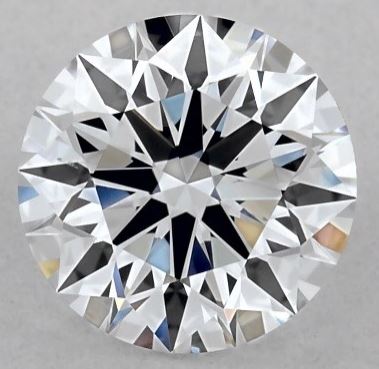We are reader-supported. Buying through any red colored link on our site may earn us commissions. Learn More.
Up to 30% off engagement rings and select jewelry at James Allen!
What are Enhanced Diamonds?
Enhanced diamonds start as very included or low color diamonds and then undergo specific treatment for improving either their clarity or diamond color. Treatment aims to reduce the appearance of inclusions or improve color, though enhanced diamonds have some drawbacks. Enhanced diamonds differ from natural diamonds that are left in their natural state and do not go through treatment.
Enhanced diamonds generally sell for approximately 30-50% less than natural diamonds with the same characteristics.
Trustworthy sellers will be upfront and tell you the diamond is enhanced and in most cases, sellers are legally obligated to disclose this.

Bottom Line Recommendation:
Because your engagement ring is something you or your partner will wear for many years, it’s important to make a smart decision. While diamonds shouldn’t be considered a financial investment, you still want to spend wisely. Rather than an enhanced diamond, it’s best to go with a natural diamond or lab-created diamond like this one from James Allen that withstands daily wear, remains beautiful and maintains some of its value.
Why you should trust us
How To Identify an Enhanced Diamond?
You can identify an enhanced diamond by looking at its certificate or getting information from the diamond seller. In most cases, sellers are legally obligated to disclose when they’re selling an enhanced diamond. Trustworthy diamond dealers will specify in the diamond’s description that it is an enhanced diamond. You might also be able to identify an enhanced diamond by noticing if it appears to be super bright white or ultra eye-clean.
Price and Value
Enhanced diamonds sell for approximately 30-50% less than natural diamonds with the same characteristics. The price is lower for enhanced diamonds, but so is the quality. Enhanced diamonds are less valuable than natural diamonds and are difficult to resell. Enhanced diamonds are also less durable due to the treatment they receive. Reputable lab entities like the GIA don’t usually offer certificates to enhanced diamonds, because most of the treatment is temporary, and therefore, the grading is as well.
Overall, there are fewer guarantees with enhanced diamonds and a lower value. Some sellers might try to convince you that an enhanced diamond is a smart buy, but it’s important to know what you’re getting with an enhanced diamond. In this guide, we cover the types of enhanced diamonds, the pros and cons, and our bottom line recommendation.

How Diamonds are Enhanced
There are two types of diamond enhancements: clarity enhancement and color enhancement. Clarity enhancement is a treatment that attempts to make inclusions less visible. Color enhancement is a treatment that attempts to make the diamond appear more white or appear to have a distinct color like yellow or green.
“A relatively small percentage of gem-quality diamonds are [enhanced] and they are treated for two reasons: to improve clarity or to alter color.” “Over the years, advances in technology have resulted in more sophisticated diamond clarity and color treatments. Some modern treatments, though, have a significant drawback: they can improve a diamond’s appearance, but may not be permanent.” Gemological Institute of America (GIA)
Clarity Enhancement
There are four types of clarity enhancement: deep boiling, laser drilling, special laser drilling and fracture filling. These methods aim to reduce the appearance of inclusions in a diamond. Many times they also impact the diamond’s structure and brilliance. In essence, inclusions are “cavities” that are full of black material. If you’re able to clean out the cavities, the inclusion becomes less noticeable.
Deep Boiling
With this method, diamonds are boiled under deep pressure in an acidic solution. The procedure is done on diamonds with black inclusions that reach the surface of the diamond. If an inclusion is beneath the surface, the deep boiling method won’t penetrate and impact the inclusion.
Deep boiling doesn’t fill the cavity, it only removes the dark material so the inclusion becomes less noticeable. Deep boiling is an inexpensive and common procedure in the diamond industry. Most diamond manufacturers deep boil large batches of diamonds to clear out any black inclusions that reach the surface.
This treatment doesn’t impact the value of the diamond and is a well-respected method. In fact, deep boiling diamonds is the only clarity enhancement method approved by the GIA.
Laser Drilling
When a diamond has black inclusions that don’t reach the surface, a laser can be used to burn a microscopic hole in the inclusion. Once the laser opens up the inclusion, the diamond is then deep boiled to remove the dark material and clear out the inclusion.
As the GIA explains, this is a permanent treatment that enhances the diamond’s clarity. However, it can have a negative impact on the diamond’s strength.
With the laser drilling process, a small tunnel inclusion forms in the diamond where the laser is drilled. The formation of tunnels reduces the durability of the diamond. It’s also possible for dirt to become stuck inside the tunnel. The GIA does not sanction this procedure. That’s why any seller must legally disclose the diamonds that have undergone laser drilling.
Special Laser Drilling
Special laser drilling involves burning a microscopic thin layer on the diamond’s surface to reach the inclusion. These thin spots are larger than the laser drill tunnels but usually look more natural. The flat plane inclusion is also easier to fill than the tunnels that are created by regular laser drilling.
While the thin layer on the diamond is hard to detect, it still impacts the durability and quality of the diamond. The GIA does not sanction this process and does not issue certificates to diamonds that have undergone special laser drilling.
Fracture Filling
With fracture filling, inclusion cavities are filled with a microscopic amount of silicon and other compounds. Fracture filling is best for clear “feather” type inclusions that are empty cavities that can be filled to look nearly invisible. Many times, when a diamond is special laser drilled, the fracture is then filled.
Fracture filling can impact the diamond’s appearance and brilliance. From the top, the diamond might appear flawless but when viewed from other angles, the filling can disrupt the passage of light through the facets. Fracture-filled diamonds can become cloudy or hazy over time. Sometimes air bubbles can even get trapped in a filling.
The GIA does not certify diamonds that undergo fracture filling, because it impacts the beauty and longevity of the stone.
Pros and Cons of Clarity Enhanced Diamonds
When it comes to clarity enhanced diamonds, there are some pros and cons to consider. Check out the list below to help you determine if an enhanced diamond is a right buy for you.
Pros
- Less expensive — usually 30-50% less expensive than non-enhanced diamonds
- May appear more eye-clean at a glance
Cons
- Lower value than natural, non-enhanced diamonds
- No reliable certification, as the GIA does not grade laser-drilled or fracture-filled diamonds
- Weak structure and low durability due to laser drilling
- Cleaning is more difficult because enhanced diamonds can’t undergo ultrasonic cleaning or high temperatures due to possible damage
- Lower brilliance as filling compounds impact how light reflects off the diamond
- Can appear cloudy or hazy over time due to the fillings
- Difficult to resell or trade
- Repairing and resizing a ring can be challenging due to heat restrictions
- Must notify jewelers and cleaners that you have an enhanced diamond as to avoid damage when cleaning, repairing or resizing your ring
Color Enhancement
Color-enhanced diamonds undergo a high pressure, high temperature (HPHT) process to alter their color. Diamonds with a slight coloring might go through this process to make them appear whiter. Slightly tinted diamonds also may be color enhanced to enrich their color, making them a distinct tone like yellow or pink.
HPHT Diamonds
The HPHT color enhancing process uses a cubic press to add a super thin layer of chemicals or plastics to the diamond’s surface. The added thin layer can make a diamond either whiter or give it a more distinct color. Colorless diamonds that undergo this treatment might begin with a yellow or brown tint, and emerge looking colorless.
Diamond sellers must legally disclose that a diamond underwent HPHT treatment because it permanently changes the diamond from its natural state. On a GIA certificate, the diamond will be described as “artificially irradiated” or “HPHT annealed.” GIA only issues treated diamonds with a permanent change.
A color enhanced diamond has less value than a natural diamond because it underwent a treatment that isn’t natural. The color enhancement is likely to wear out over time, impacting the beauty and longevity of the diamond. That’s why color enhanced diamonds are less expensive.
Should you buy an Enhanced Diamond for your Engagement Ring?
No, we don’t recommend an enhanced diamond for your engagement ring, as you can get better value for your money with a natural diamond that falls within your budget. Alternatively, a lab-created diamond can give you a beautiful look as well.
Enhanced diamonds are priced lower than natural diamonds and lab-created diamonds, but they don’t offer long-term value. Enhanced diamonds can deteriorate in quality and they’re difficult to resell.
Lab-created diamonds are an alternative to enhanced diamonds that are still less expensive than natural diamonds. Lab-created diamonds mirror natural diamonds in their physical and optical properties. They’re certified and maintain their durability and beauty over time. And they can be found at lower price points than natural diamonds. For example, this beautiful 0.95 Carat VS2 H diamond from James Allen costs $1,330.
You can also learn how to find a natural diamond within your budget by not paying too much for any given feature. For example, in our educational guides, we help readers learn how to find a clarity grade that will be eye-clean, while not paying more than is necessary. For instance, this 0.90 Carat SI1 diamond from James Allen is eye-clean and costs $3,690. It saves you $850 or 23% on a similar VVS1 clarity graded 0.90 Carat diamond from James Allen. Both diamonds are eye-clean, but one is significantly less expensive.
For a personal recommendation on a diamond that fits within your budget, reach out to our experts.

- No questions asked returns within 30 days of shipment. James Allen will send you a paid shipping label to return the ring.
- Lifetime Warranty
- Free International Shipping
- Free prong tightening, repolishing, rhodium plating and cleaning every 6 months
- Provide insurance appraisals
- One free resizing within 60 days of purchase
- Free ring inscriptions
- Best-in-class high quality imagery of all diamonds in stock
- 24/7 Customer Service
- Best-in-class packaging


- No questions asked returns within 30 days of shipment. Blue Nile will send you a paid shipping label to return the ring.
- Lifetime Warranty
- Free Shipping
- Free prong tightening, repolishing, rhodium plating and cleaning every 6 months
- Provide insurance appraisal
- One free resizing within the first year of purchase
- High quality images of about half of their diamonds
- 24/7 Customer Service
- 100% credit towards future upgrades (must be at least double in value)
- Best in class fulfillment

Still afraid of getting ripped off?
Before you buy a diamond, get personal buying advice from industry veterans. We'll help you get the best diamond for the money.
Ask your diamond purchase question here
DISCLAIMER: We don't use your email for marketing. Period.
You Might Like
Diamond Prices: A Complete Guide
A diamonds’ price is determined primarily by the 4 Cs of the diamond. On the wholesale level, diamond prices are first based on a diamond shape and
The Best Places to Buy Engagement Rings
Buying an engagement ring is often one of the first major purchases in a person's life. The process can be fraught with tension as there are so m
1 Carat Diamond Price & Buying Guide
A wide range of 1 carat diamonds exist both in online markets and local diamond jewelry stores. Not only are there significant differences in beauty



